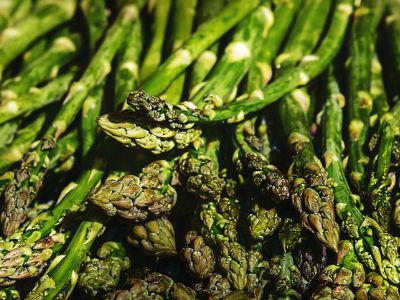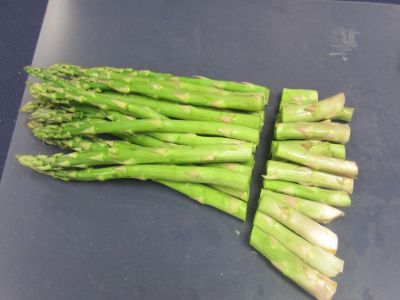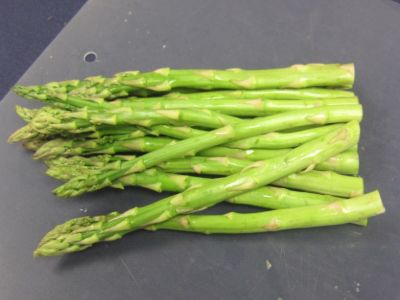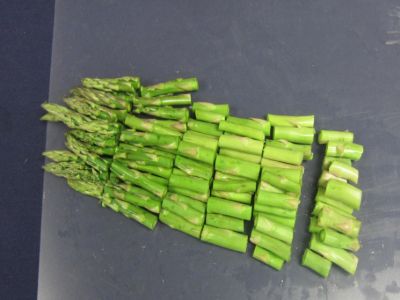Asparagus

Preparation: Step-by-Step

Wash hands. Thoroughly rinse asparagus
to remove any dirt.

Chop off white, woody ends.
These ends have a tough texture.

If roasting or grilling, leave spears whole.

If sautéing or using in stir-fry, chop asparagus
into bite-size pieces of about one inch.
Grow.
- Plant one- or two-year-old crowns (stem and roots) in full sun six weeks before the
last spring frost. Plant crowns 18-24 inches apart in trenches eight inches deep.
Spread roots in bottom of trench and cover with 1-2 inches of soil. Gradually cover
with more soil as growth progresses. Provide 1-2 inches of water every week, especially
during first year, but do not overwater. Consider mulching in mid-summer to help control
weeds.
For more growing information, look for the MSU Extension MontGuide: Planting a Successful Home Vegetable Garden, or contact your local MSU Extension office.
Harvest.
- Harvest in summer, only after the third year. Snap 6- to 10-inch long, pencil-thin spears close to the ground. Do not over harvest.
- Choose odorless, pencil-thin to 1/2-inch thick asparagus spears with dry, tight tips. Avoid limp, wilted, or extra-large, woody spears.
- Refrigerate asparagus up to four days by wrapping bottom ends of stalks in wet paper towel and placing in a plastic bag.
- Most vegetables are rich in fiber and phytochemicals, but provide negligible amounts of saturated fat, trans fat, cholesterol, and sodium and are gluten-free. Asparagus is high in folate and potassium and is a good source of Vitamins K and A, with only 20 calories per half-cup serving.
Grill/Broil.
- Place asparagus in a plastic bag, drizzle with olive oil and low-sodium seasoning. Shake until asparagus is coated, then put spears on a preheated (medium-high heat) grill or under a hot broiler. Cook about 5-8 minutes until tender, turning occasionally.
Microwave.
- Place asparagus in a microwave-safe container with a small amount of water, low-sodium seasoning, and garlic. Cook for 3-4 minutes or until desired tenderness is reached.
Raw.
- Rinse and dry asparagus and enjoy as is, or in your favorite dip or salad.
Sauté or Stir-fry.
- Drizzle cooking oil in a heated pan. Add low-sodium seasoning with bite-size or one-inch pieces. Cook asparagus by stirring over high heat until desired tenderness, about 5-8 minutes.
Roast.
- Place asparagus in a plastic bag, drizzle with olive oil and seasoning. Shake until asparagus is coated, transfer spears onto a baking sheet or pan, then roast in oven at 400° F, about 5-8 minutes.
Season.
- To enhance flavor, season with allspice, basil, dill weed, ginger, marjoram, nutmeg, thyme or lemon juice.
Steam.
- Place asparagus in a pan with a small amount of water, low-sodium seasoning, and garlic. Cook on medium heat for 8-10 minutes or until desired tenderness.
Preserve.
-
- For more information on preserving vegetables, view these MSU Extension MontGuides: Freezing Vegetables, Drying Vegetables, and Home Canning Using Boiling Water and Pressure Canners. Or contact your local MSU Extension office.
For More Information:
Montana State University Extension: msuextension.org
MSU Extension Master Gardener: mtmastergardener.org
MSU Extension Food and Nutrition: nutrition.msuextension.org
MSU Extension Nutrition Education Programs: buyeatlivebetter.org
Date of Publication: January 2014
